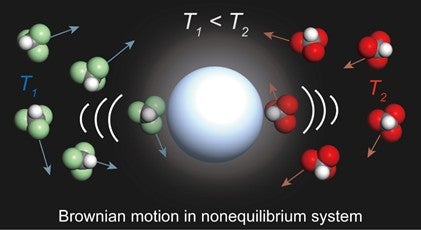Lighting up Brownian ballistic velocity
LIU Xiaogang (Group Leader, Chemistry) () July 05, 20165 Jul 2016. NUS scientists have co-developed an optical method for measuring the instantaneous Brownian velocity of colloidal suspensions in non-equilibrium systems using upconversion nanothermometry.
The random movement of microscopic particles in both liquids and gases is known as Brownian motion. Understanding Brownian motion provides an intimate insight into a microscopic world and enables us to answer questions on how substances interact with each other at different time scales. It has been challenging using conventional techniques to measure Brownian motion due to the rapid and random movements of the particles at a very short time scale of 10-10 sec (namely, ballistic regime). Since Brownian motion is extremely sensitive to temperature variation, nanothermometry which monitors thermal fluctuation at the nanoscale level is a tool which can be utilized for studying the Brownian motion of nanoparticles.
A team led by Prof LIU Xiaogang from the Department of Chemistry at NUS and Prof Luis CARLOS from Universidade de Aveiro, Portugal, together with researchers from Institute of Materials Research Engineering, A*Star, Nanjing University of Posts and Telecommunications, and Nanjing Tech University, China, has demonstrated the use of upconversion nanothermometry for measuring the instantaneous ballistic velocity of nanoparticles with different sizes and shapes. Measuring the instantaneous velocity of these tiny particles in a Brownian system, however, has proved to be a daunting task, as evidenced in the groundwork of Einstein in 1907. The research team is not aware of any other proven solution for measuring the instantaneous velocity of sub-100 nm Brownian particles.
Their work has also verified Einstein’s prediction made in 1907 that the instantaneous Brownian velocity is independent of particle size and shape under infinite dilution conditions. Better understanding of Brownian motion of suspended particles in non-equilibrium systems would have an invaluable impact in a wide range of scientific fields. For example, it allows improved understanding of thermal conductivity, convective heat and mass transfer in various types of nanofluids.
Optical tweezers are often used as a versatile tool to trap particles while measuring their three-dimensional displacements with high temporal and spatial resolution. Both the ballistic Brownian motion in gas and the transition from ballistic Brownian motion to diffusive Brownian motion have been observed through such optical trapping techniques. However, there are several fundamental limitations associated with this force-spectroscopy based technique. First, it applies only to particles of several microns in diameter, requiring the construction of costly optical instruments with sensitive position detectors and high-power trapping laser. The best time-resolution achieved by optical tweezers which is in the order of 10-8 sec is not sufficient. Unlike the particle trapping approach, extremely diluted nanofluid sample is not required for measuring Brownian motion using upconversion nanothermometry-based technique.
Upconversion nanocrystals can be well-dispersed into various solvents, providing a versatile platform for investigating ballistic Brownian motion in non-equilibrium systems and related phenomena without the stringent constraints associated with optical tweezers. The newly developed technique could be used to achieve a more thorough understanding of fluid properties. It can also be extended into biological systems to understand the transport of molecules and cells.

Figure shows a Brownian nanoparticle suspended at a solvent interface between a cold (T1) and a hot (T2) region. The temperature-driven Brownian motion of the nanoparticle leads to a solvent mixing effect. [Image credit: Xian QIN]
Reference
CDS Brites, et al. “Instantaneous ballistic velocity of suspended Brownian nanocrystals measured by upconversion nanothermometry”. Nature Nanotechnology. DOI:10.1038/nnano.2016.111.


